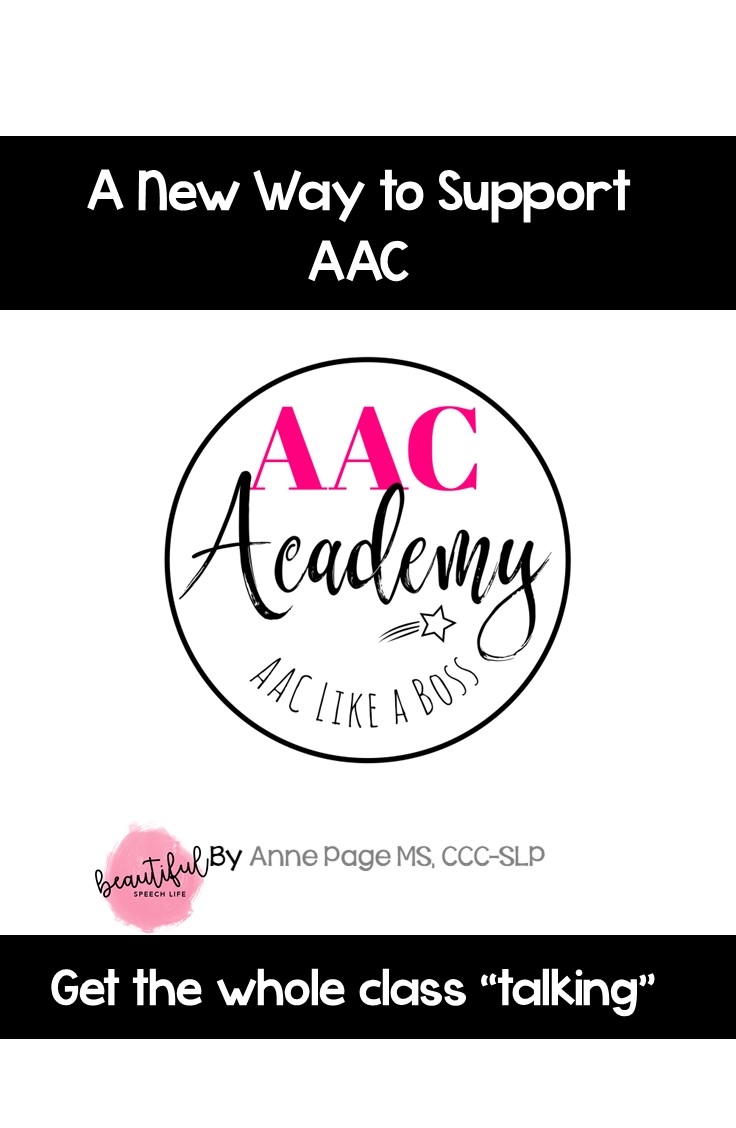by Anne Page | Dec 10, 2014 | Freebies, Therapy Ideas
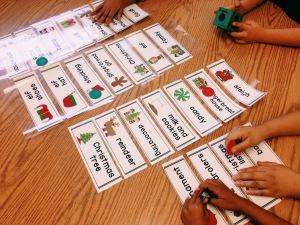
This is one of my groups from this morning. I got these Christmas word cards on Teachers Pay Teachers from Mrs. W for FREE! I laminated them in long strips and laid them out on the table . The kids took turns tossing red or green poker chips and naming the word that their chip landed on. Later in the day I had one group make sentences with the words, another group gave definitions. They thought it was great fun!
by Anne Page | Sep 30, 2014 | Evaluations, Freebies
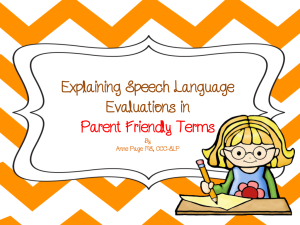
So you’ve completed your testing and written your report. Now it’s time to present the results to the student’s parents. This is delicate work; use empathy and try to put yourself in the parents’ place. Know your “audience”. This is not a time to dazzle them with your brilliance or to use all of the vocabulary that you learned in grad school.
Remember, we have our own lexicon and so does the education world. This can be a little overwhelming. A few years ago, I was in a meeting where a well-meaning special education resource teacher was telling a parent that her son was behind in his ability to decode and comprehend grade level informational text. She talked for a while and then asked the parent if she had any questions. The parent said, “you lost me 10 minutes ago, I have a 6th grade education and I have no idea what you are talking about.” That’s something I won’t ever forget.
Parent friendly language is really important. We want to invite understanding and collaboration. When we are giving standard scores, percentiles, and standard deviations below the mean; we need to interpret and not overwhelm with information. Here are a few tips that I have found helpful:
- Start with the child’s strengths, every parent wants to hear some good things about their child
- Use pauses, take breaths. Try not to be nervous and rush through the information.
- Encourage questions. If parents have a glazed look or are just nodding in agreement with everything-not a good sign.
- Use visuals (don’t assume understanding of the Bell Curve) I created a simple visual that you can use to give an overall picture of what the child’s communication strengths and areas for improvement are. The score range varies slightly by test but generally the average range is from 85-115. Mark scores right on the sheet or put in a plastic document cover and mark with dry-erase marker. This is not meant to replace the Bell Curve, it’s just an additional way to make results clear for parents. Click Here for your free download.
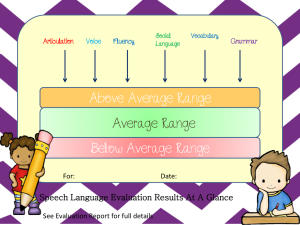
- Provide examples
- Explain how this will affect the child in his classes
- Hopefully you had a chance to explain what areas you were testing at the pre-evaluation meeting. Now would be the time to briefly explain again the different areas of speech and language. I use this chart available in my Teachers Pay Teachers Store.
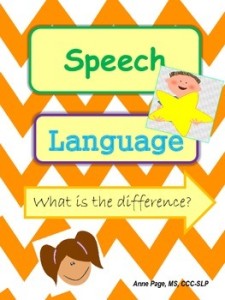
- Let them know that you are available to answer any additional questions after they’ve had the opportunity to read the complete evaluation
- If it looks like the child will qualify for services, give the parent an idea of what this will look like
- Ask the parent what area they would like to see their child improve in first
Parents are such an important part of the team approach, the more they understand; the stronger your team will be!
by Anne Page | Sep 6, 2014 | Freebies, Therapy Ideas
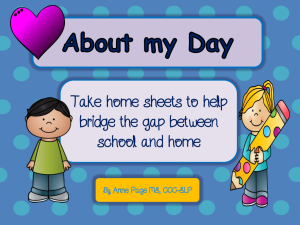
Imagine that you are a parent. Your little cutie pie comes home after being at school (and away from you) for seven hours. You want to know all about their day!
“How was your day sweetie?”
“Good.”
“What did you do?”
“Play.”
“What else?”
“That’s all.”
This is a normal conversation even for a typically developing child. But with prompting, he should be able to tell you the basic events of his day. On the other hand, a child with an expressive language impairment may lack the organizational structure and vocabulary to be able to recall the events of their day. The ability to remember and tell about the people, places and things he encountered is a foundational skill for the next step of sequencing. Recognizing the order of events is a vital skill for organizing thoughts.
After having many conversations with parents at IEP meetings or in the clinic waiting room, I wanted to make something tangible to help bridge this communication gap. My little client Suzy (not her real name), is six years old and couldn’t really tell her mom much about her day. Or if she did, she would repeat the same events every day saying things like “I went for recess” or “I played with my friends”. I put a worksheet together for her, talked to Suzy about it, and gave Suzy’s mom some ideas on how to give her some choices and prompts when Suzy says “I don’t know”. This was her homework for the week until I would see her again. We are now on our fifth week of homework. Suzy’s mom says Suzy requests it every night. Yay! We keep changing the three things and Suzy is learning some organizational thought processes and giving more details. The other great thing is that it is a multi-sensory experience with the colorful visuals (Suzy loves the colors and the kid graphics), she is touching the paper, she is writing, she is talking to her mom about it and she is talking to me about it. And she is practicing the skill in multiple environments for much more effective carryover.
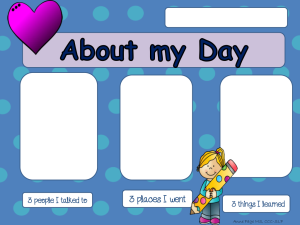
The “About My Day” worksheets are available as a FREE download from my Teachers Pay Teachers store. (Scroll down for the link or www.teacherspayteachers.com/Product/About-My-Day-Take-home-sheets-for-expressive-language-1432730 ). With colorful fun visuals and the “3 things” structure these worksheets are linked to Common Core standards and can also serve as writing prompts.
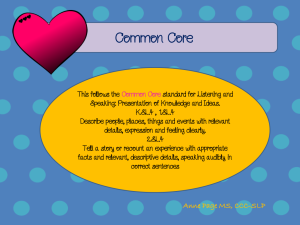
If a student is in a special education classroom, it may be appropriate for an adult to fill it in or use pictures. I use a color sheet as the cover page and staple six b/w copies behind it. Included are two versions (girl graphic, boy grapic) and two blank sheets to use as masters. (Make sure you set your printer to landscape setting). Or if you want to use it with your iPad, open it in Ibooks or the PDF reader app, then make a screen shot and open it in Skitch. Use your finger or a stylus to write with.
I hope you enjoy these!
by Anne Page | Aug 28, 2014 | Evaluations, Freebies

What is the best way to explain the difference between speech and language to parents and to teachers? I know many times there are misconceptions that we SLPs only deal with articulation errors and stuttering. Accordingly, parents can wonder why their child is being referred to talk about the possibility of a language evaluation, when their child doesn’t mispronounce anything.
That is where our role as advocates and educators comes into play. A simple explanation to parents can be a good starting point. The American Speech Language and Hearing Association (ASHA) provides a clear explanation at http://www.asha.org/public/speech/development/language_speech/. We can paraphrase this in our own words, using parent-friendly language. I always find visuals to be extremely helpful; so I created these posters that are available to download for FREE on TeachersPayTeachers. (Scroll down for the link).
At our school, we display them in the room where we have our IEP/MET meetings. They are a great tool to use when explaining evaluation results. For the teachers at our school, I do a brief inservice at the beginning of the school year, explaining speech and language and how all goals are linked to curriculum standards. I also make myself available for quick consultations for teachers when they have concerns about a student.
I hope you enjoy the download, keep making the world better one child, one word at a time!
Anne








 Hey there I’m Anne Page. I help heart centered SLPs and educators put the fun in functional communication.
Hey there I’m Anne Page. I help heart centered SLPs and educators put the fun in functional communication. 